Menu
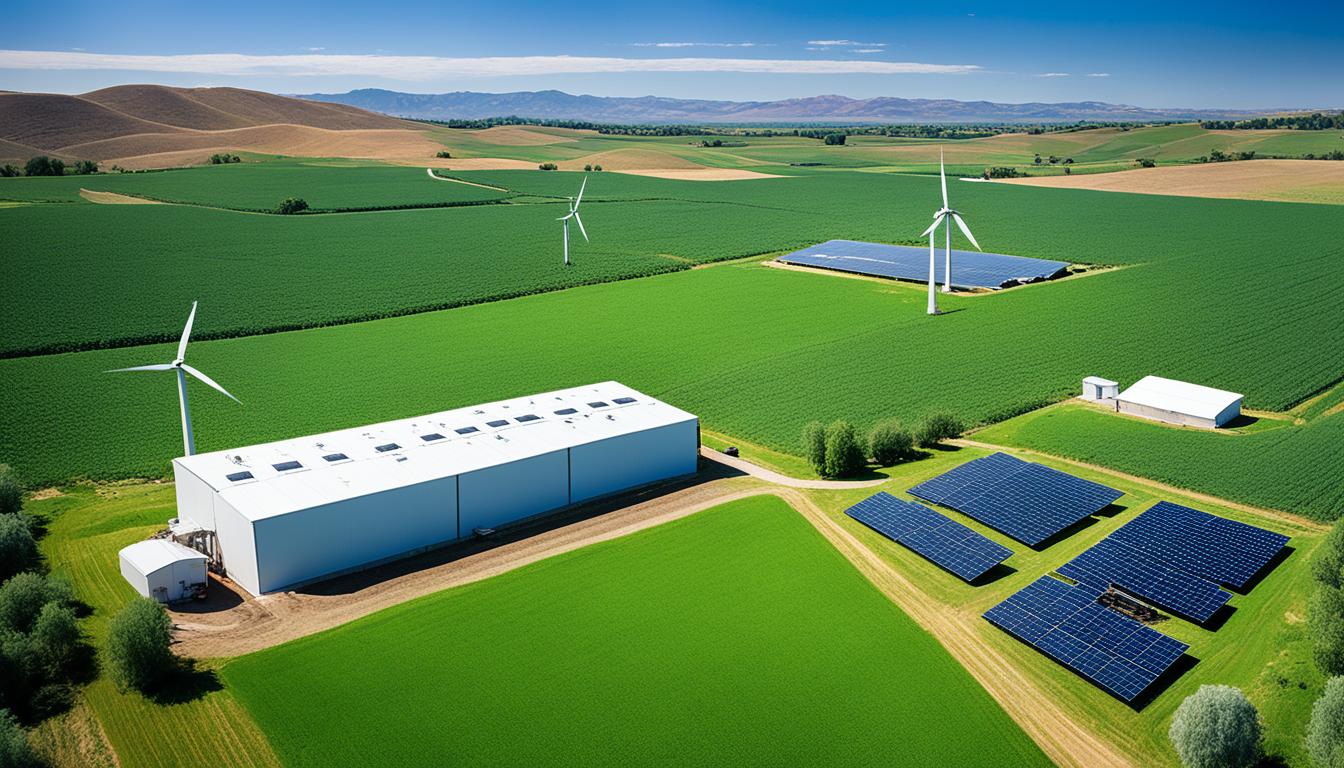
California stands out in the US for its vast agricultural production. It includes over 400 different items and makes about half of the nation’s fruits, nuts, and vegetables. This large and varied farming scene is facing new demands to meet water quality rules. Around 6 million acres of California’s farmlands comply with the Irrigated Lands Regulatory Program (ILRP). This program looks after water discharges from farming and gives out rules or waivers to farmers.
About 40,000 farmers are part of the ILRP, making following these rules a big deal. From the Northern Coast’s modest 270,000 acres to the Central Valley’s huge 6,200,000 acres, all farmers need to farm sustainably. This means they must use practices that are good for the environment and keep their land healthy. The ILRP wants to cut down on water pollution and make sure farming is done in a way that lasts. It aims for a mix of high productivity with looking after the land.
High water quality is vital for farms and the core of sustainable farming. Due to changing rules, farmers must keep up with water standards closely. The following rules are crucial for staying compliant.
Water’s role in farming is huge. It’s needed for crops, animals, and more. If the water isn’t clean, it harms the soil, the food, and can make people and animals sick. So, clean and safe water is a necessity in farming for successful and healthy outcomes.
The new regulations aim to boost environmental care in farming. They include tough quality rules, detailed inspections, and strict record-keeping. Water must be treated and checked to lower the risk of harmful bacteria like E. coli.
Yearly checks of the water systems are a must as each season starts. Potential pollution sources should be found and fixed. If water issues can’t be controlled, using special chemicals may be needed. Water used for crops must be tested often to make sure it’s safe for use.
By following these water quality regulations, farmers ensure they don’t harm the environment and follow good farming methods. Such actions protect public health and the land for future farming.
| Regulatory Aspect | Description |
|---|---|
| Water Quality Requirements | Ensure water is safe and sanitary for its intended use. |
| System Inspection | Annual inspection at the start of each growing season. |
| Water Treatment | Recommend antimicrobial treatments for uncontrollable issues. |
| Water Testing | Regular testing for E. coli and other contaminants. |
It’s crucial to know how agriculture affects water quality. This knowledge is vital for controlling water pollution effectively. Runoff from farms is a key concern. It’s called nonpoint source pollution. We will look at what this means and how farming causes it.
Nonpoint source pollution is when water gets polluted by many sources together. This is different from a single, easy-to-spot source of pollution. Farms are a big reason for this type of pollution. They let sediments, nutrients, and harmful germs flow into water. This harms water and the creatures living in it.
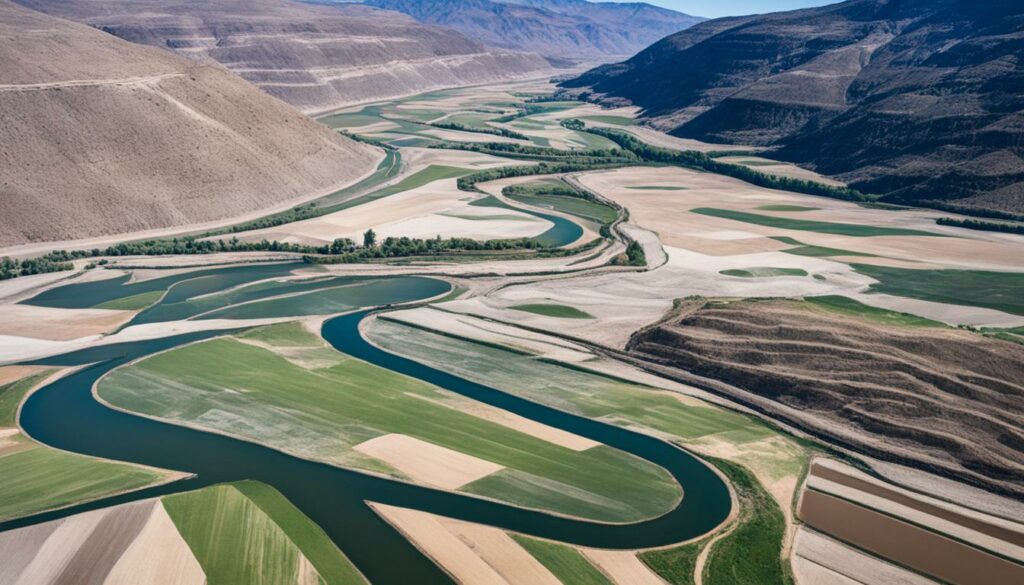
Farming plays a big part in water pollution. The use of pesticides and fertilisers can harm water. Also, animal waste, which is about 500 million tons every year in the U.S., adds too many nutrients. This can make water bodies unhealthy for life.
Farmers can help by following strict water safety rules. These include checking water systems and testing water well.
The FDA is working to make sure farm water isn’t contaminated by dangerous germs like E. coli. They want no E. coli found in 100 ml of water during some activities. And there are yearly checks to make sure everything’s okay. These steps are vital to protect the environment and water resources.
“Agricultural nonpoint source pollution is a top concern for water quality in rivers and lakes. This shows we need to control it well.”
The Environmental Quality Incentives Program (EQIP) helps farmers with money and advice. It encourages them to use farming methods that protect the land. This reduces harmful effects on water.
Efforts to manage nonpoint source pollution are growing. Many grants are given to fight pollution from farms. By working together, the farming sector can make water cleaner. This leads to a healthier environment for everyone.
Sustainable farming tackles today’s big food issues. With nearly two billion more people expected by 2050, we need to grow food smartly. These practices help us produce more food while keeping our water safe. They also help farmers stay in business for the long haul.
Sustainable farming is all about balancing food needs with nature. It uses methods that help us get lots of food without hurting the planet. Things like changing the crops grown in an area each season, not tilling the land too much, and using good bugs to control bad bugs, are key.
These methods keep our water clean, our soil healthy, and help more plants grow.
| Practice | Benefit |
|---|---|
| Crop Rotation | Enhances soil fertility and disrupts pest cycles |
| Conservation Tillage | Reduces erosion and improves water retention |
| Integrated Pest Management | Minimises pesticide use and protects water quality |
These smart farming methods also save money. They cut the costs of things like man-made fertilisers and bug killers. This helps local communities and offers a better life for small farmers. Studies show that farms certified for good water practices make more money than others.
Farming this way helps us always have enough to eat. It makes sure everyone can afford good food. The approach also keeps our water safe as a top priority.
Supporting sustainable farming is key to feeding a growing world, saving nature, and building lasting economies.
It is crucial to adopt new ways of farming that are good for the environment. These help meet water quality rules and do not harm the land in the long term.
Cover cropping means planting crops like legumes or grasses to protect the soil. These are not used for food. They make the soil better, stop it from washing away, and help water soak in. The plant roots hold the soil in place and stop pollution from reaching the water. They also add important nutrients to the soil, keeping it fertile.
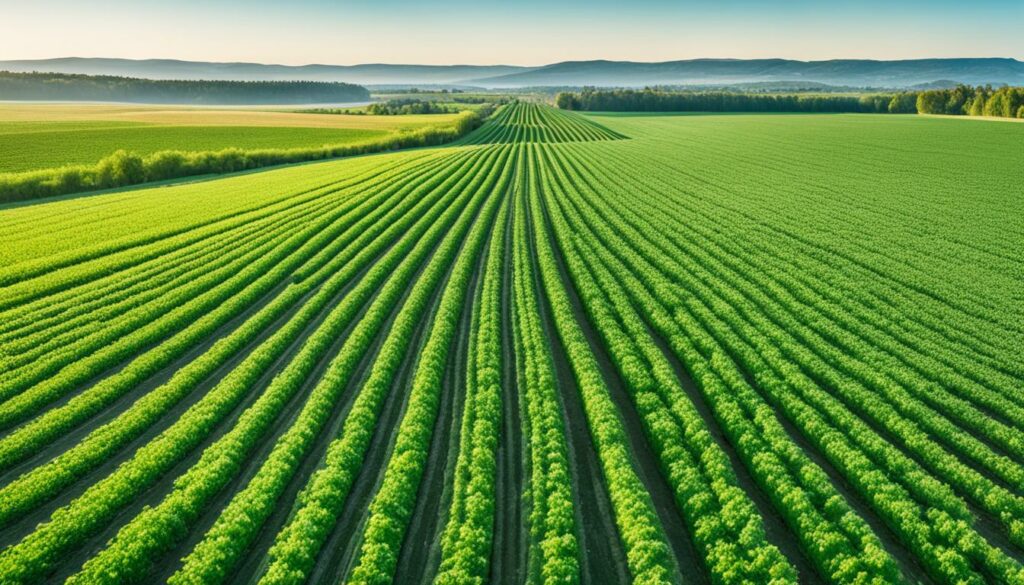
Conservation tillage helps the soil by keeping it covered and not breaking it up too much. This method lessens soil erosion and stops pollutants from getting into the water. It helps the soil stay moist, stores water better, and follows the rules about keeping water clean.
Using cover crops and conservation tillage together really helps the environment. They make sure farming does not harm the water or soil. They lead to ecosystems being healthier and farms being able to stand against challenges.
| Water Testing Requirement | Standard |
|---|---|
| No detectible E. coli per 100 ml | Agricultural water that directly contacts the harvestable portion of a crop |
| Geometric mean of no more than 126 CFU per 100 ml | Untreated groundwater used for irrigation |
| Statistical threshold value of 410 CFU per 100 ml | Untreated surface water for growing activities |
As per FDA, farmers have to check the water’s E. coli level and keep it below limits. They must do this by collecting samples every year. This is to make sure the water and crops are safe.
Following water quality rules is key in farming today. These rules help farming activities meet water quality standards and protect the environment.
The FDA’s standards aim to make produce safer by fighting off pathogens in water used in farming. These rules cover checking water quality, examining water systems, treating water, and thorough water tests.
The policy on water quality says water touching crops or food surfaces must be clean. This includes water for crop irrigation and washing picked produce.
A big part of these rules is tough water testing. It sets limits, like no E. coli found per 100 ml in water used after harvesting. Also, it includes keeping untreated water’s E. coli levels within safe bounds.
The FDA uses a step-by-step plan for making sure surface water is safe. This involves initial surveys, yearly checks on water quality, and recalibrating standards. These steps aim to guarantee safety and meet regulations while focusing on sustainable farming.
About 30% of the Chesapeake Bay watershed is covered by farmlands. These farms, over 83,000, play a huge role in agriculture. It’s crucial they stick to sustainable practices. From 2018 to 2020, NRCS helped improve farming on 1.26 million acres, an area as big as Grand Canyon National Park.
The USDA’s plan to give $22.5 million in conservation aid in 2022 shows the drive to maintain farm productivity and clean water. With solid rules and help from these organizations, farmers can meet water quality steps for a brighter future in farming.
The Chesapeake Bay watershed is a prime example of successful conservation and eco-friendly farming. Here, efforts in agriculture show real benefits to the environment. This proves that good agriculture policies can lead to a cleaner world.
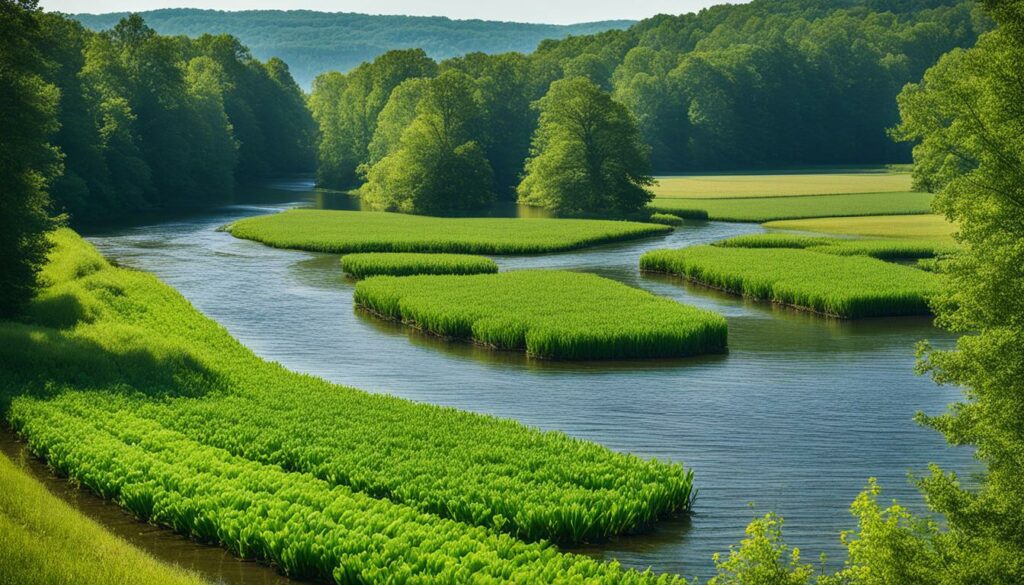
In the Chesapeake Bay area, both the government and private groups work hard for conservation. They focus on trading between different sources, which started in 2005. This approach allows for more people to join in and trade, improving conservation efforts.
It’s clear that this trading system works well in big areas like the Chesapeake Bay. More trading happens where the rules are clear and there’s a lot of demand, showing that good policies help the environment.
Sustainable farming in the Chesapeake Bay area has had a big positive effect. By using eco-friendly practices, farmers have cut down on water pollution. This has made water cleaner.
Also, the big area and many people involved make this region a good example of successful trading. The success stories here help guide others in improving their water quality. A report from rbouvier consulting and Footprints in the Water talks about the Chesapeake Bay’s success in trading, thanks to strong state support.
The National Water Quality Initiative (NWQI) started in 2012 with help from the USDA’s NRCS. It works with the EPA and state agencies to improve water in key areas. NWQI has helped over 5,600 farms across 1,190,000 acres since then.
NWQI aims to improve water quality through farming practices. It wants to keep farms productive while boosting the environment. The initiative helps with things like better nutrient management and conservation farming.
States are key to checking how well these schemes work. From 2017 to 2020, about 36% of monitored sites got much better in at least one pollution measure.
NWQI has had some great wins. Since it began, many once-poor waterways are now in better shape. These changes mean they don’t need as much urgent help to heal.
Most of these improvements, over 73%, come from farmers changing up how they farm. This shows it’s really making a difference.
| Year | Milestones |
|---|---|
| 2012 | Launch of NWQI by NRCS with EPA collaboration |
| 2019 | Introduction of source water protection projects |
| 2023 | Extension of NWQI with further updates for enhanced delivery |
The work done is smart and involves lots of local help. NWQI even has a big project in Texas. There, it focuses on making sure farm runoff doesn’t harm water, proving farming can be both profitable and eco-friendly. NWQI is a model for good farm practices that protect our water.
The Mississippi River Basin Healthy Watersheds Initiative (MRBI) is all about managing watersheds wisely. It started in 2009 and aims to reduce nutrients in the water and make water quality better. The project uses a mix of actions and plans.
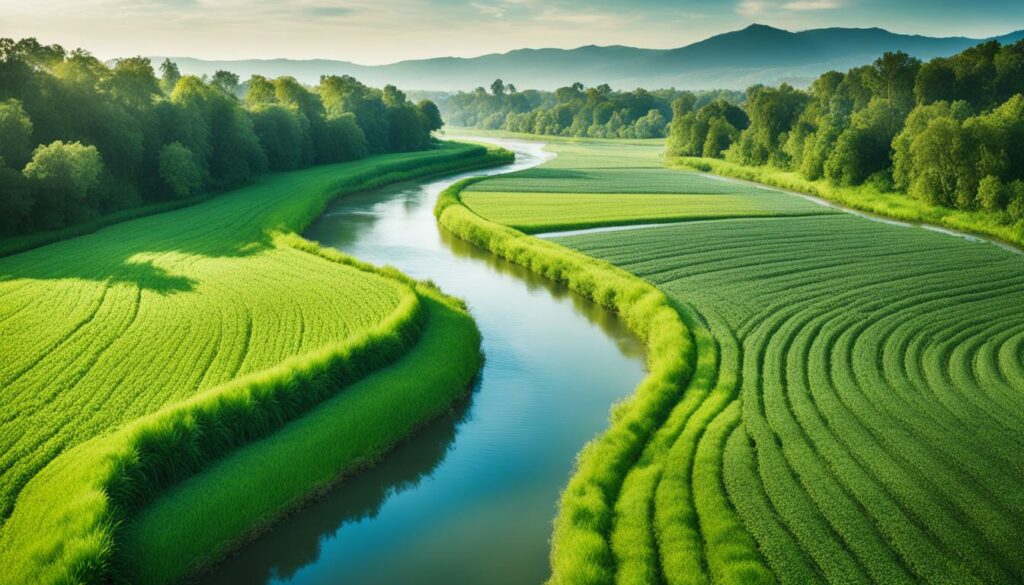
The MRBI works hard to cut down on nutrients. It uses methods like planting cover crops and managing nutrients in 12 states. These methods have become much more popular, spreading by over 30%.
With a focus on nutrient management, they tackle the issue of less nitrogen and phosphorus washing into waterways. This change reduces water pollution. Overall, efforts have cut down on dirt wash off by 2.4 million tons. They’ve also reduced phosphorus and nitrogen in runoffs by 5.5 million pounds and 20.2 million pounds, respectively.
The MRBI points to practices that care for the land and water together. Techniques like no-till farming, cover crops, managing left-over plant material, and planting grass near water help a lot. They reduce problems from water flowing over farmland. The project also checks water before it leaves farms, so farmers can see how their actions affect the water. This helps make smarter farming choices and supports more efforts to look after the land.
Working together, the Mississippi River Basin Initiative is making big strides in water quality and sustainable farming. They are building a healthy environment that helps farms and nature grow together.
The Great Lake Restoration Initiative (GLRI) is working hard to fix many problems in the Great Lakes. Since 2010, it has been focusing on stopping invasive species and bringing back the natural health of the land and water. Thanks to these efforts, we’re seeing big improvements in the health of the lakes and their surroundings.
Stopping invasive species is key for the Great Lakes’ health. With GLRI’s help, over 2,600 acres of land have been cleared of harmful plants and animals in places like Wisconsin and Michigan. This work is vital in keeping local plants and animals safe from invaders.
Fixing watersheds and protecting wetlands is also a big part of the GLRI mission. They’ve helped save over 8,200 acres of wildlife spaces in places such as Michigan and Wisconsin. This helps lower the levels of phosphorus in the water, which stops harmful algal blooms.
| Key Statistics | Data |
|---|---|
| Conservation Contracts Entered Since 2010 | 2,700+ |
| Acreage Covered | Over 613,000 acres |
| Phosphorus Reduction | 1.1 million pounds |
| Invasive Species Controlled | Over 2,600 acres |
| Wildlife Habitat Protected/Restored/Enhanced | 8,200+ acres |
| Regions Impacted | Ohio, Michigan, Minnesota, Wisconsin, Indiana |
| Funding Aim for 2026 | $475 million |
The GLRI is getting more money to do its important work, with $450 million given for 2025. The aim is to reach $475 million by 2026. This support not only helps the environment but also boosts the local economy. A study by the University of Michigan found that every dollar spent helps add $3.35 to the region’s economy.
The Arkansas Groundwater Initiative (AGWI) fights the falling water levels in the Arkansas Delta. It encourages farmers to use water more wisely. This helps keep farms sustainable by saving precious groundwater.
Small or new farmers, those facing tough times, and even certain groups like Indian Tribes, can get extra help. By certifying in a form, they may earn more money for using better water management. These farmers can get some money upfront for the materials they need too.

The chance to ask for help in saving water ended on Nov. 4, 2022, for next year’s support. There are about 200 ways this project can help, made for different types of farms and forests. This means each producer can find something that suits them to save water.
There are also special supports for those who farm organically or want to save energy. The AGWI focuses on helping farms in a few key areas. These include places like Arkansas and parts of Cross, Lonoke, and more.
There’s more than one effort to make water cleaner and preserve wildlife habitats. The National Water Quality Initiative (NWQI) and the MRBI are also working towards cleaner water. All these plans show a big effort to look after Arkansas’s water well.
Getting support for your farm goes through a careful selection process. The best projects for the environment get the highest help. This assures the most critical work gets the support it needs.
Checking water quality is key for sustainable farming, making it efficient and eco-friendly. With farms covering about 30% of the Chesapeake Bay area, good monitoring matters a lot. Technicians use edge-of-field methods for accurate data, which helps farmers make the right choices.
Edge-of-field methods are crucial for farmers. They allow direct impact measures of conservation actions. The NRCS has helped over 83,000 farms in the Bay area to apply these methods. Offering aid on 1.26 million acres, it’s like the Grand Canyon Park, aims to gather precise data on runoff and nutrient loss.
Using this data is crucial for smart farming. It improves how crops are handled and water is used, which boosts outcomes. Starting in 2012, the NRCS worked with 5,600 producers through the NWQI. This led to better land management on more than 1,190,000 acres.
Edge-of-field methods have helped track 16 water bodies improving and being close to be removed from NWQI’s list. Stress on using data ensures decisions enhance water care while also boosting farm results and being eco-friendly.
Government funding plays a key role in encouraging eco-friendly farming. It supports many green efforts in the agricultural sector. Funding comes from various programs and grants aimed at improving farming techniques.
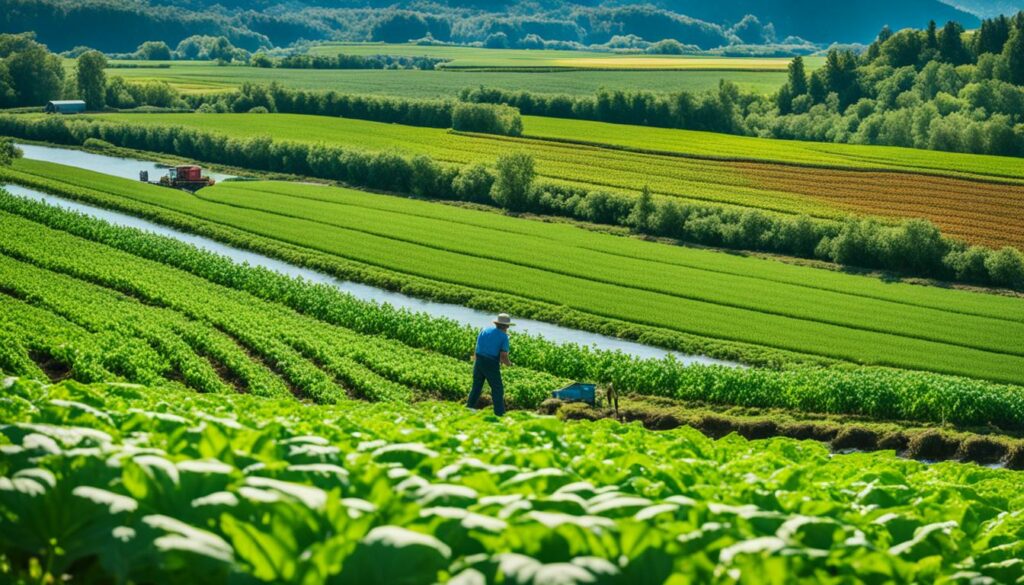
Take the Chesapeake Bay watershed, for instance. Here, farms cover almost a third of the land. They produce over $10 billion every year. The USDA has significantly helped out in this region. From 2018 to 2020, over 1.26 million acres saw better farming methods thanks to their help – that’s as big as the Grand Canyon National Park.
This financial year, the USDA plans to spend an extra $22.5 million on farm conservation. This adds to the $1.1 billion these grants and funding have already provided in the last ten years. The NRCS, with the help of more than 5,600 farmers, has improved over 1.19 million acres of land since 2012. Their work has made the water cleaner in at least 16 places.
Besides the Chesapeake Bay, other regions have seen improvements too. The Mississippi River Basin initiative, for example, has upped water quality work by 30% since it started in 2009. The outcome is less pollution and better water. The Great Lakes project has managed to cut over 1.1 million pounds of phosphorus from the water in its target zones since 2010.
| Government Program | Purpose | Impact |
|---|---|---|
| Conservation Reserve Program (CRP) | Yearly rental payments to remove environmentally sensitive land from production | Preserves natural habitats and reduces erosion |
| Conservation Reserve Enhancement Program (CREP) | Targets high-priority conservation issues | Improves water quality and wildlife habitat |
| Emergency Conservation Program (ECP) | Funding to restore farmland damaged by natural disasters | Assists in rapid recovery and sustainability |
| Farmable Wetlands Program (FWP) | Annual rental payments for wetland restoration | Enhances wetland ecosystems and water quality |
| Grassland Reserve Program (GRP) | Prevents conversion of grazing land to cropland | Maintains pasture lands and prevents urban sprawl |
| Source Water Protection Program (SWPP) | Protects surface and groundwater used as drinking water | Ensures safe drinking water for rural communities |
In summary, government funding for sustainable farming is crucial. It ensures the environment is looked after without hurting farm incomes. The support provided by the farm bill and various grants is proof of a dedication to both saving the planet and helping farmers.
Using agricultural technology is key for environmentally friendly farming methods that boost both efficiency and nature protection.
We now have tools like precision agriculture that use sensors. These sensors keep an eye on the environment. They help us use less water and make the soil better. For example, water sensors check the pH, temperature, and oxygen levels in water that plants need. By keeping track of these, we can feed the plants better, leading to bigger harvests.
When sensors find out the pH of the soil, we can manage nutrients better. This, in turn, helps us grow more food. Checking the water’s temperature also prevents plant problems. It does this by stopping the lack of nutrients. This all fits a way of farming that cares for the environment. This kind of farming uses less water that can harm the environment. It’s a big step in solving over 90% of water problems in farming.
Then, there are smart tools that use things like artificial intelligence and the cloud. They team up with sensors to do smart farming. These tools turn lots of data into helpful actions. Using them can make more food, make it better, and use less stuff. They even help make food safer and make work better for farmers.
Robots and smart machines also play a big part. They do jobs very precisely. This makes farming more efficient but uses less power. Plus, in cities, new farming methods make safe and fresh food right where people live. This helps with the big issue of making sure there is always enough food.
Let’s see what water sensors can do:
| Water Quality Parameter | Implications for Agriculture |
|---|---|
| pH | Improves nutrient management |
| Temperature | Prevents nutrient deficiency and crop damage |
| Dissolved Oxygen | Indicates water quality health |
| Electrical Conductivity | Manages soil salinity |
| Turbidity | High levels can lead to eutrophication |
Investing in farming tech that helps save resources is very important. It helps with big problems like not enough water and tired soil. This smart use of technology and nature-friendly farming means we can meet our needs today without hurting the chance for others tomorrow. It moves us closer to farming in ways that the whole world has agreed on since the 1970s.
Nutrient management is crucial for sustainable farming. It’s key for both protecting the environment and boosting crop growth. Using fertilisers wisely and stopping excess nutrients from entering our water is important. These steps help farms work better and protect our planet.
Good nutrient management begins with proper fertiliser use. Farmers need to apply nutrients in just the right amount, at the right time. This means looking at what the plants need and not using too much.
Modern tools like soil testing and smart application methods can help. They give farmers the exact data needed. This way, fertilisers are used only where necessary. This helps crops grow better and protects the environment.
Stopping nutrient runoff is a big issue in farming. But, there are ways to help, like using conservation tillage and planting buffer strips. These methods cut soil loss and help clean runoff water by catching harmful materials.
Using terraces and basins can also stop soil loss and reduce nutrient runoff. Besides these ways, trading nutrients has become a new, hopeful option. It allows farmers to earn credits by cutting down on nutrient pollution. By doing this, they can avoid some costs of treating their wastewater. It’s a win for both the economy and the environment if done right.
Key practices include cover cropping, and conservation tillage. Also, using fertilisers wisely. Adding water pollution controls is essential too.
Good water quality is vital for growing crops and keeping animals healthy. It stops dirty water from harming our environment and us.
A: New rules focus on tackling farm runoff and managing nutrients better. They aim to cut water pollution and safeguard our waters.
Farming adds to water pollution mainly through runoff. This includes pesticides, fertilisers, and soil. Such pollution can harm our water sources.
Going green saves money in the long run. It increases crop yields and helps you stick to environmental rules. This may also bring in extra cash and less trouble.
Cover cropping is about planting crops to shield the soil when nothing else is growing. It fights erosion, boosts soil health, and keeps water clean and land strong.
These methods are about farming that disturbs the soil less. They keep soil together, cut down on erosion and runoff, and help keep our water clean and land healthy.
These rules mean farmers must fight pollution, test their water, and follow certain steps to keep water safe. Break them and you could face fines and limits.
In the Chesapeake Bay area, green farming has made water cleaner, brought back more plants and animals, and cut pollution. It shows how farming can thrive while keeping nature safe.
The NWQI sets out to better water in key areas. It backs farmers to do greener farming that reduces pollution and handles water better.
They push for good nutrient plans, use farming that’s kinder on the land, and give farmers know-how. This aims to cut nutrient leaks and boost water quality.
It fights invasives with removal programs and looks to get the land and water back in shape. This includes projects to make water cleaner and restore natural homes.
The AGWI’s aim is to stop water levels from falling in the Arkansas Delta. It helps farmers save water, use it better, and care for this vital resource.
Farming uses tools like water sensors and tests, plus data crunching, to watch over water. This guides doing farming that’s good for the land and keeps resources safe.
The government gives out money, offers green help, and shares knowledge through things like the farm bill. This helps farmers do eco-friendly farming, up their game, and look after nature.
New tech like smart farming gadgets, flying drones, soil sensors, and clever data systems make for better, greener farming. They save resources, work smarter, and help the land stay healthy.
Top ways to handle nutrients well include using fertilisers efficiently, planning nutrient use, stopping leaks with cover crops and zones, and keeping an eye on the soil. This ensures nutrition for crops without risking water quality.